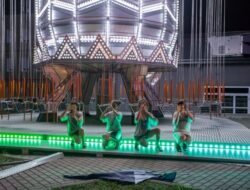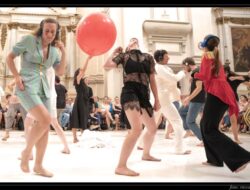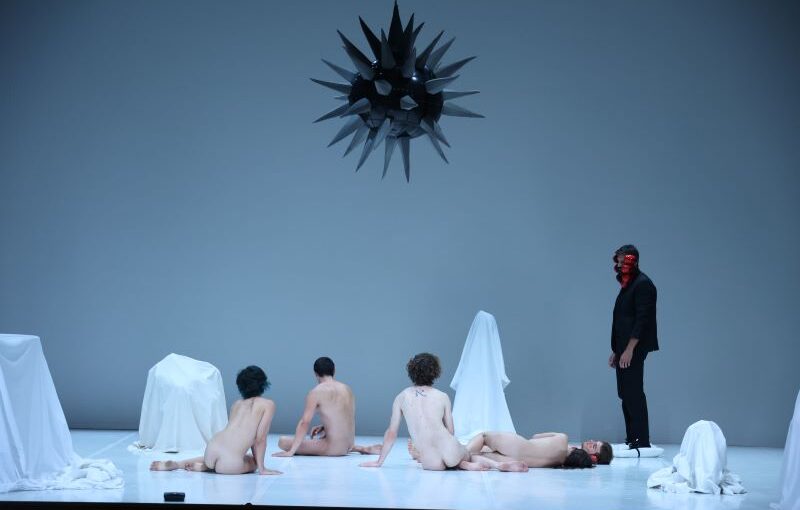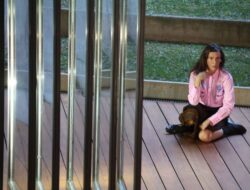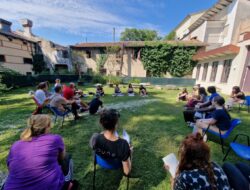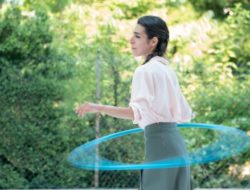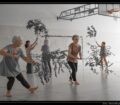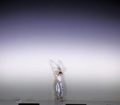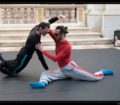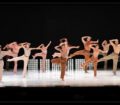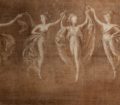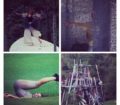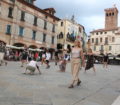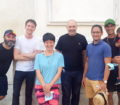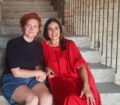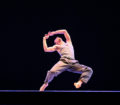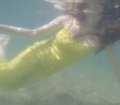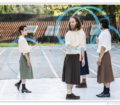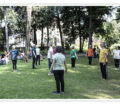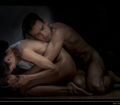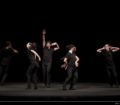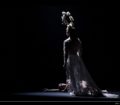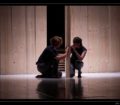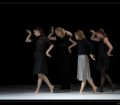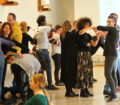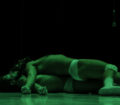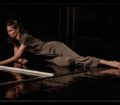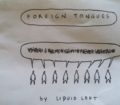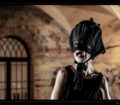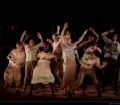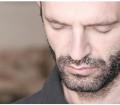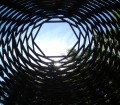Prelude | On disappearance
“I believe so fully in the power of performance that I don’t want to convince anyone. I want the audience to experience my performance and walk away with their own convictions.”
Marina Abramović
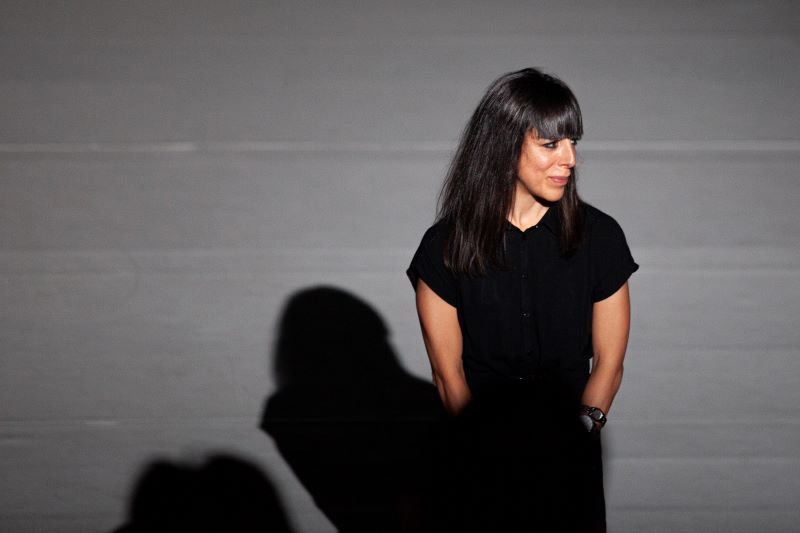
Francesca Pennini in “Manifesto Cannibale”. Photo by C. Farina
Francesca Pennini, in a black dress, greeted us radiantly…
“One of my closest friends told me — ‘Tell the truth!’ — the truth is that I am Francesca Pennini and I’ve produced this show but I don’t yet know what I’ll see. I am unprepared. I offer you my unpreparedness” – she announced, instantly transforming us d’emblée into accomplices in a scenic game. It promised to be both onerous and spectacular as it was already clear that it would entail clues and instructions, trails and adumbrations. Indeed, at the theatre’s entrance we had been handed a veritable manual (disguised as a theatre programme): arranged as enigmas and hermeneutic deviations. We all took the time to read it, or leaf through it, prior to the performance.
Pennini proclaims that she has authored the direction of this show, even though she has never actually seen it in its entirety, not even during rehearsals. With intonations as if in a confidential confession, she mischievously vows her coming disappearance from the stage: “Manifesto Cannibale began as a research project on otherness and immobility. It became complicated by the pandemic and by my personal vicissitudes (seven bone fractures, involving vertebrae and both tarsi). […] I chose to disappear and not watch the performance or video rehearsals. I entrusted Angelo Pedroni fully with the direction.”
While re-browsing the manual in our hands, we were intrigued to read that, ancillary to the production — “a tree will be planted at each performance.” Planted where and by whom? We did not know, but we resolved to make our first great leap of faith or, more prosaically, grant the artists our unconditional trust, and prepare ourselves, at last, for the viewing.
Ghosts, phantoms and unveilings
φύσις κρύπτεσθαι φιλεῖ
“Nature tends towards concealment”
Heraclitus (Diels–Kranz fragment 123)
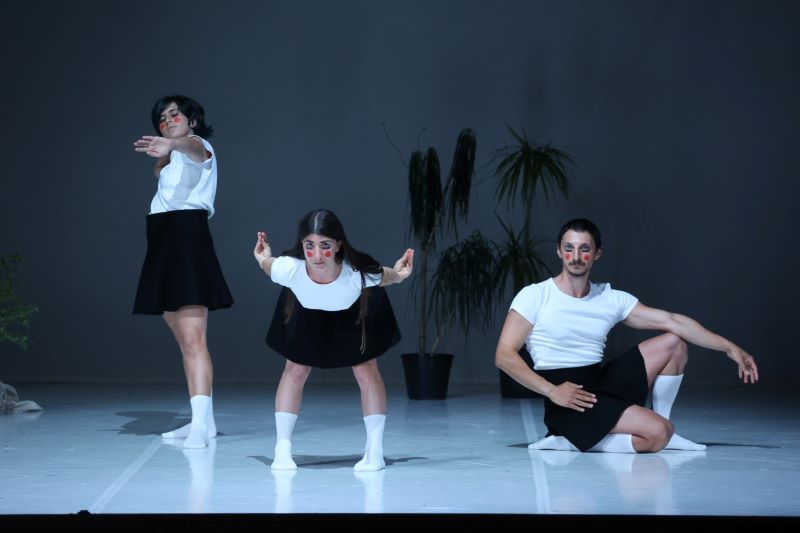
BMotion Danza 2023 | “Manifesto Cannibale” by Francesca Pennini/ CollettivO CineticO. Photo by Giancarlo Ceccon
It was undoubtedly a ‘fantastic’, ‘phantasmagorical’, ‘spectral’ spectacle that we witnessed. Only in part due to the prevailing colour palette picked for the miscellaneous costumes and props: blacks and whites. Monochromatic tones that fused the collective imagination with ghostly glows and the tenebrosity of shadows, moreover suffused with Gothic literature (absent the murky obscurities, the horror) or even a hovering luminescence from a long lost alchemy, reaching beyond Marguerite Yourcenar’s The Abyss, bringing about an allusive rubedo, daubed upon the performers’ cheeks in a loud and faux-incongruous flush. The overall effect generated by the blacks and whites illuminated by the redness on the dancers was curiously reminiscent of that uncanny ‘automaton effect’ evoked by E.T.A. Hoffmann’s The Sandman, yet in a synthetically iconic way.
It is a ‘fantastic’ show in that it is hauntingly inhabited by a host of ghosts. Phantasmagorical objects, veiled by immense white sheets; luminous wraiths that alternate in the darkness. What’s more they are activated by sound too: traces of presences foretold and then obscured. In short, a continuous and ‘spirited’ game of disclosure and concealment, of phenomena and apparitions, of disappearances and rediscoveries.
It is a ‘fantastic’ production for it swings over abysmal issues without ever falling, suspending us momentarily with bated breath, only to burst out in howls of hilarity.
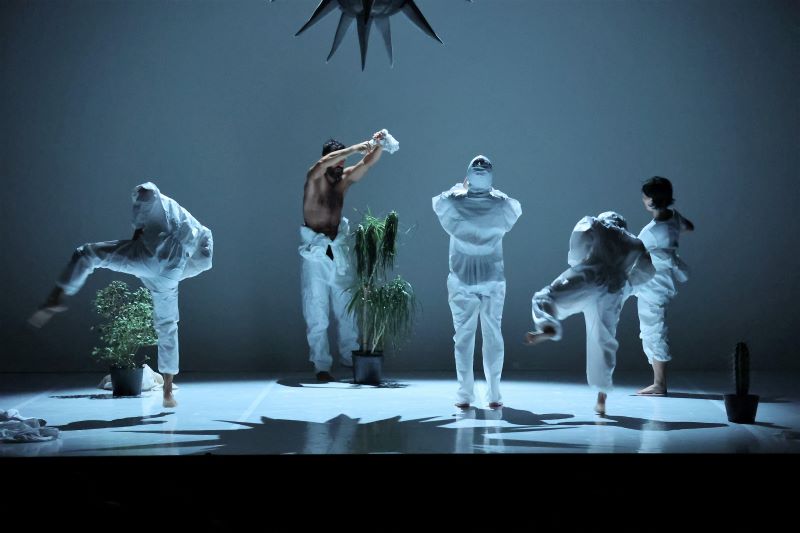
BMotion Danza 2023 | “Manifesto Cannibale” by Francesca Pennini/ CollettivO CineticO. Photo by Giancarlo Ceccon
It is a ‘fantastic’ performance because a fantastical and illustrious spirit reverberates throughout the first part of the show: the spectre of Franz Schubert. A visitation via the unmistakable notes of his Lieder cycle Winterreise (Winter Journey, 1828), a masterpiece consisting of Wilhelm Müller’s poetry set to piano, composed shortly before Schubert’s death, bestowed here on the audience thanks to Pennini’s resolute audacity (albeit not in its entirety). Schubert’s music manifests itself in all its magnificence, in a directorial masterpiece of unabashed devotion to a set repertoire — contiguous to themes explored by Romeo Castellucci in his Schwanengesang D744 (2013).
Schubert’s Winterreise succeeds in carving out space for darkness and the retinal night that reverberates rhythmically on stage, forging a dramatic, economical score. The fact that Winterreise is performed live on the piano reconnects us all to a romantic intimacy that Schubert had originally intended for just a handful of cherished friends, allowing it to glisten in a contemporary ambience in all its bleak, hibernal relevance.
Immobility, blindness and epiphany
“Ich kann zu meiner Reisen
nicht wählen mit der Zeit,
muss selbst den Weg mir weisen
in dieser Dunkelheit”.
“I cannot choose the time
for my journey;
I must find my own way
in this darkness.”
Schubert/W. Müller, Winterreise (Gute Nacht, Lieder 1)
“The waking have one common world, but the sleeping turn aside each into a world of his own”
Heraclitus (Diels–Kranz fragment 89)
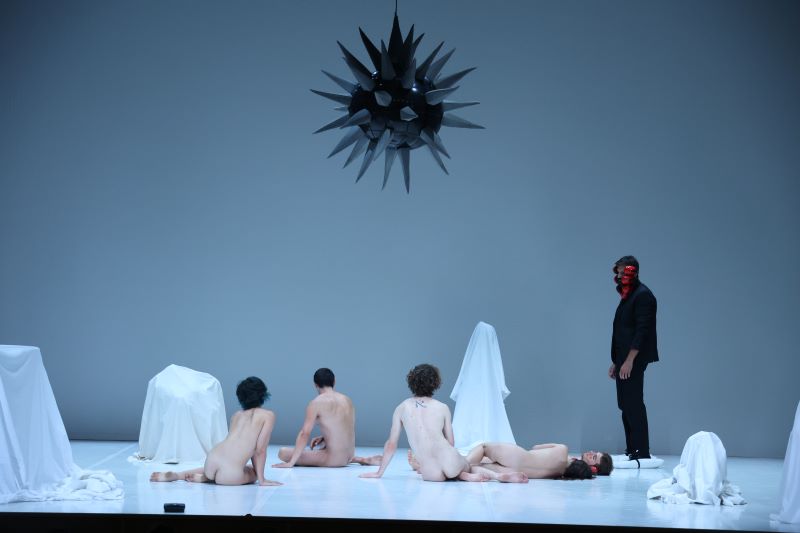
BMotion Danza 2023 | “Manifesto Cannibale” by Pennini/CollettivO CineticO. Photo by Giancarlo Ceccon
Unrobed and asleep, amongst objects veiled with a white sheet, the dancers submit themselves in the first of a series of paintings that accompany the first section. A black sun gleams from on high, a spiky sphere whose form recalls a virus, or perhaps an anti-body.
In a metaphysical milieu without movement, a shrouded Francesca Pennini, a presence prior to apparition, is immobile under a large white drape, hidden. We snatched a glimpse of her, seated and still, concentrated in a hieratical, front-facing pose. For an elongated moment an echoed vision was supplanted in our mind’s eye: The Two Fridas (1939), Frida Kahlo’s familiar self-portrait in which the seated artist duplicates herself.
Then the audience was invited to strike the spark in order to wake the dozing performers with an unnamed with a novel scenic device (one which I do not wish to reveal here). The awakening begins, with the complicity of stage costumes and objects juxtaposed in a somewhat surrealist manner (disclosing one: a pair of cushions employed as skates to dampen the patter of footsteps).
The items on stage, swathed in white, remained utterly motionless while one performer went around to wake up all the other sleepers.
The inky-blackness which beset the auditorium then yielded to the returning light: at first dim, almost blurry, rounded, reactivating our vision just in time to see one actor uncover, one by one, the objects on stage: a houseplant, a thorny cactus… The click-clicking of their shoes stung the senses as they went, until the serene reprise of the Winter Journey Lieder chilled the air atingle once more. New darkness and new light, annular and hazy, dilating into alien sounds which contrived to deform the bodies on stage into shadowy silhouettes. The man in black uncovered a grand piano and began to play Schubert. The red bulbs in the lamps flicker to each icy note struck on those black and white keys.
With a deft stage effect (that I won’t spoil), Francesca Pennini breaks free of her immobility and freezes the stage action of the rest of the performers. It is now that the truth is divulged. After which she reanimates the activities that she had interrupted, voluntarily surrendering herself to her own disappearance.

“Manifesto Cannibale” by Francesca Pennini/ CollettivO CineticO. Photo by C. Farina
In a flash this veiled presence before us furnishes an additional impression, that of the Wanderer above the Sea of Fog (c. 1818), so emblematic of Romantic art. The Rückenfigur (rear-facing figure) is the exemplary narrative device developed by Caspar David Friedrich to offer perspective (and interior) depth to the viewer’s gaze. His innovation, for a moment, seemed like a plausible pictorial parallel to Pennini’s own staged vanishing act. She also takes advantage of it to generously outline her own creative process, allowing herself to be observed and vivisected in a manner analogous to that reserved for her performers. A complex game of refractions and representations that enchants, convolves, reflects upon itself and irrevocably compels the beholder to contemplate.
In the alternation of dark and light we close our eyes from time to time and then slowly open them again as the piano shimmers over those melancholic and sublime harmonies of Winterreise. The cyclical intermittence between day and night, white and black induces a state of semi-hypnosis in the spectators. One in which the eyes become increasingly refractory to light and the eyelids intimate blindness as a singular and daring perspective to re-perceive the scene intra-visually. In a crescendo of optical obscuration, Schubert’s refrains played live rouses our imagination or, at least, the desire to imagine in a dissimilar mode from our retinal picture of reality playing out on stage before us. We experience the wonder of splitting, our Doppelgänger dispersed into an unknown universe. We experience the epiphanic efficacy of darkness. It teaches us to see through and beyond things.
Play and laughter as antidotes to death
“Never having seen a ghost before, he naturally was terribly frightened, and, after a second hasty glance at the awful phantom, he fled back to his room, tripping up in his long winding-sheet as he sped down the corridor, and finally dropping the rusty dagger into the Minister’s jack-boots, where it was found in the morning by the butler. Once in the privacy of his own apartment, he flung himself down on a small pallet-bed and hid his face under the clothes. After a time, however, the brave old Canterville spirit asserted itself and he determined to go and speak to the other ghost as soon as it was daylight.”
Oscar Wilde, The Canterville Ghost
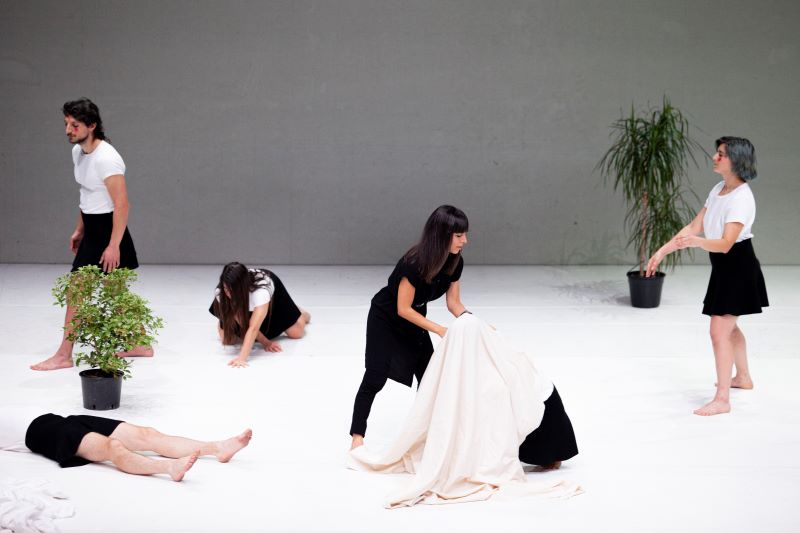
“Manifesto Cannibale” by Francesca Pennini/ CollettivO CineticO. Photo by C. Farina
The four performers laid down on the floor, recumbent beneath a snow white sheet, just leaving their feet undraped. Isolated, these twitched as if animated with a life of their own, in a jocular tête-à-tête between troupes of assorted toes in concise, tacit chatter.
Then darkness designated a subsequent scene, perhaps the most prepossessing and propitious of the entire production. Whilst the pianist performed the Schubert piece, the four dancers initiated a certain game, one that we have all played as children (which I again refute to divulge here as it would ruin any surprise). The playful mechanism is so well constructed, so skilfully conducted by the performers, so lucidly modified by an awakening Francesca Pennini, interposing herself, amplifying the whimsical outcome of the action so exhilaratingly that it sweeps the audience into uncontrollable hysterics. This burst of laughter bolsters the bond between audience and actors in an extraordinary way, dispelling any residue of distrust towards a dramaturgy that devours itself, indeed because it cannibalises itself so very blatantly.
Till the end of (our own) world
“Between four hundred million and one billion years ago, unlike animals, which had to move around to find their food, plants took an evolutionarily opposite direction: they remained in place […].”
Stefano Mancuso, The Revolutionary Genius of Plants: A New Understanding of Plant Intelligence and Behavior
“Dance me to your beauty with a burning violin
Dance me through the panic ‘til I’m gathered safely in
Lift me like an olive branch and be my homeward dove
Dance me to the end of love
Dance me to the end of love”
Leonard Cohen, Dance Me to the End of Love
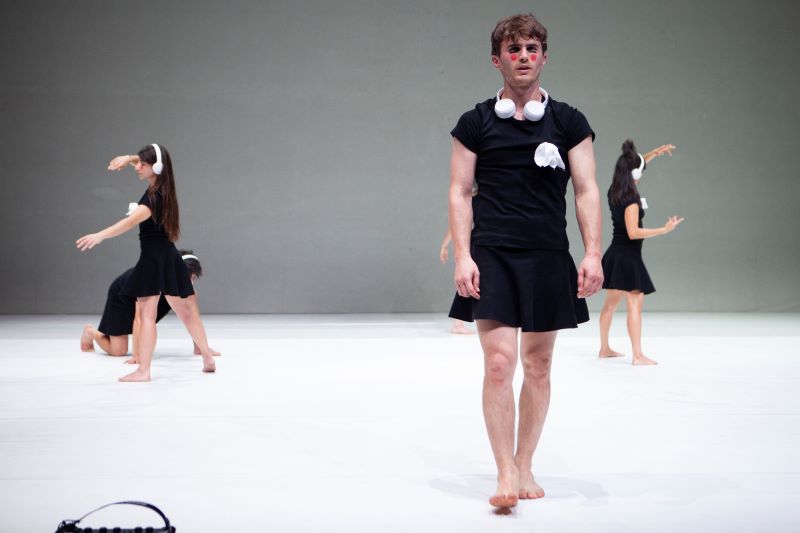
“Manifesto Cannibale” by Francesca Pennini/ CollettivO CineticO. Photo by C. Farina
Till the light again disarms the darkness, dislocating it into extremities of elongated, unearthly shadows, which then disperse into vast refractions of colour. Till Pennini intones a cannibalistic love song. Till we are told — “This is the end of the dance and the beginning of Manifesto Cannibale. There is no time for the end. Those on stage will stand completely still for as long as possible. This is a contest of endurance, during which you the audience are quite free to leave.”
We experience the fascination of immobility as well as the catharsis of its violation. We are moved by the absorbed meditation that arises from the paralysis of action. We confront the exhaustive boredom of inaction and loss of control over muscular reactions. We undergo the vegetative state of bodies, their ability to resist and persist on this earth. Without falling.
Anna Trevisan
English translation by Jim Sunderland
Photos by Giancarlo Ceccon and C. Farina (curtesy of CollettivO CineticO Archive)
Cover image by Giancarlo Ceccon
TESTO ITALIANO
Preludio | Della sparizione
“Credo così tanto nel potere delle performance che non voglio convincere nessuno. Voglio che gli spettatori facciano esperienza della mia performance e se ne vadano via con le loro convinzioni.”
Marina Abramović

Francesca Pennini in “Manifesto Cannibale”. Photo: courtesy of CollettivO Cinetico Archive/C. Farina
Francesca Pennini ci accoglie sorridente in un abito nero.
“Uno dei miei più cari amici mi ha detto: ‘Dì la verità!’. La verità è che sono Francesca Pennini e firmo questo spettacolo ma non so che cosa vedrò. Sono impreparata. Vi offro la mia impreparazione” – ci annuncia, trasformandoci d’emblée in complici di un gioco scenico che si preannuncia laborioso e spettacolare, perché dichiaratamente disseminato di indizi e istruzioni, tracce e indicazioni. All’ingresso del teatro, infatti, abbiamo ricevuto un vero e proprio manuale camuffato da programma di sala: organizzato in sciarade e scie ermeneutiche, tutti abbiamo avuto il tempo di leggerlo o, quantomeno, di sfogliarlo prima dell’inizio.
Francesca Pennini dichiara al pubblico che ha firmato la regia di questo spettacolo, pur senza averlo mai visto integralmente, nemmeno durante le prove. Ci annuncia giocosa la sua sparizione dalla scena con toni che sanno di confidenziale confessione: “Manifesto Cannibale è iniziato come progetto di ricerca sull’alterità e sull’immobilità. Si è complicato con la Pandemia e con le mie vicende personali (sette fratture ossee tra le quali alle vertebre e a entrambe i piedi). […] Ho scelto di scomparire e di non vedere lo spettacolo né le prove video. Ho affidato ad Angelo Pedroni la regia” – spiega Pennini.
Rileggendo il manuale che abbiamo in mano, ci sorprende scoprire come, tra gli effetti collaterali dello spettacolo, è segnalato che “un albero verrà piantato in occasione di ogni replica”. Dove e da chi verrà piantato non lo sappiamo ma decidiamo di tributare il nostro primo grande atto di fede o, più prosaicamente, di incondizionata fiducia agli artisti, e di predisporci, finalmente, alla visione.
Spettri, fantasmi e dis-velamenti
φύσις κρύπτεσθαι φιλεῖ
“La natura ama nascondersi”
Eraclito (Frammento B123 Diels Kranz)

BMotion Danza 2023 | “Manifesto Cannibale” by Francesca Pennini/ CollettivO CineticO. Photo by Giancarlo Ceccon
È senza dubbio uno spettacolo ‘fantastico’, ‘fantasmagorico’, ‘spettrale’ quello al quale assistiamo. Non soltanto per le cromie dominanti, il bianco e il nero, scelte per gli abiti e per diversi oggetti di scena. Colori che ri-allacciano l’immaginario collettivo al lucore dei fantasmi e all’oscurità delle ombre o che possono ricordare contaminazioni con la letteratura gotica (ma senza le sue cupe ubbie, senza l’orrore) o che possono richiamare un arcano codice alchemico, che si spinge oltre l’Opera al Nero della Yourcenar, innestando anche un’allusiva rubedo, dipinta in modo chiassoso e fintamente incongruo sulle guance dei performers. L’effetto complessivo sortito dal bianco e nero acceso di rosso che veste i danzatori ricorda sorprendentemente in modo sintetico perché iconico quel perturbante “effetto automa” suscitato da Der Sandmann di E.T.A. Hoffman.
È uno spettacolo ‘fantastico’ perché abitato da schiere di fantasmi e spettri. Fantasmi di oggetti, velati da grandi lenzuoli bianchi; spettri luminosi che si alternano al buio e che si attivano anche con il suono; spettri di presenze annunciate e poi occultate. Insomma, un gioco di dis-velamento continuo e ‘spiritoso’ di manifestazione e nascondimento, di fenomeni e apparizioni, di scomparse e ritrovamenti.
È uno spettacolo ‘fantastico’ perché oscilla sopra abissali questioni senza mai cadere, lasciandoci con il fiato sospeso per poi farlo scoppiare in esilarante risata.

BMotion Danza 2023 | Manifesto Cannibale” by Francesca Pennini/ CollettivO CineticO. Photo by Giancarlo Ceccon
È uno spettacolo ‘fantastico’ perché un illustre fantasma risuona per tutta la durata della prima parte dello spettacolo: il fantasma di Franz Schubert, che si manifesta nelle note inconfondibili del ciclo liederistico Winterreise (Viaggio d’inverno, 1828), capolavoro per piano e voce composto poco prima di morire, sulle poesie di Wilhelm Müller e che Pennini ha il coraggio di offrire in dono, seppur non integralmente, al pubblico. La musica di Schubert si manifesta in tutta la sua magistrale bellezza, in un capolavoro registico di devozione senza ossequio verso un repertorio contiguo a quello esplorato da Romeo Castellucci nel suo Schwanengesang D744 (2013).
I Winterreise di Schubert riescono a fare spazio al buio e alla notte retinica che ritmicamente pulsano in scena, dando vita ad una partitura drammaturgica sinestetica. Il fatto che la musica dei Winterreise sia eseguita dal vivo al pianoforte ci riannoda tutti a quella romantica intimità schubertiana riservata a pochi amici, facendola brillare in modo contemporaneo in tutta la sua austera, invernale attualità.
Immobilità, cecità e epifania
“Ich kann zu meiner Reisen
nicht wählen mit der Zeit,
muss selbst den Weg mir weisen
in dieser Dunkelheit”.
“Per questo viaggio non m’è dato
di scegliere il tempo,
da me devo trovare la via
in quest’oscurità”.
F. Schubert/W. Muller, Winterreise (Gute Nacht, Lieder 1)
“Per i desti il mondo è uno e comune, ma quando prendono sonno si volgono ciascuno al proprio”
Eraclito, Frammento 89 Diels Krantz (traduzione di Carlo Diano)

BMotion Danza 2023 | “Manifesto Cannibale” by Francesca Pennini/ CollettivO CineticO. Photo by Giancarlo Ceccon
Nudi e addormentati, tra oggetti velati con un lenzuolo bianco i performer si offrono nel primo dei quadri che ci accompagnano durante tutta la prima parte. Dall’alto splende sopra di loro un sole nero, come sfera acuminata la cui forma ricorda quella di un virus o forse di un anti-corpo.
In una scena metafisica e immobile una Francesca Pennini velata come un fantasma in procinto di apparire, sta nascosta sotto un ampio lenzuolo bianco. La intravediamo, assisa e immobile, concentrata in una postura ieratica e frontale che ci fa balenare in mente, per un lungo attimo, l’immagine di Le due Frida (1939), il celebre autoritratto di Frida Kahlo dove l’autrice raddoppia se stessa.
Il pubblico è invitato a scoccare la scintilla per risvegliare i performer dormienti, con un espediente scenico che non vogliamo svelare. Il risveglio ha inizio, con la complicità di costumi di scena e oggetti usati in modo quasi surrealista. Uno per tutti: la coppia di cuscini usata come pattine per ammortizzare il suono dei passi.
Gli oggetti velati restano immobili e bianchi mentre il performer risveglia tutti gli altri dormienti.
Dopo il buio nero in sala torna la luce: fioca, quasi sfuocata, circolare, che riattiva la vista giusto in tempo per vedere un perfomer che scopre, uno ad uno, gli oggetti in scena: una pianta da appartamento, un cactus spinoso. Il ticchettio delle sue scarpe in movimento punge i sensi fino al ritorno dei Lieder d’inverno. Nuovo buio e nuova luce, circolare e sfuocata, che si dilata in suoni alieni e deforma in silhuoette ombrose i corpi in scena. L’uomo in nero scopre il pianoforte a coda e inizia a suonare Schubert. Le luci rosse delle lampade reagiscono ai suoni battuti sui tasti.

“Manifesto Cannibale” by Francesca Pennini/ CollettivO CineticO. Photo by C. Farina
Con un riuscito effetto scenico che non spoileriamo, Francesca Pennini evade dalla sua immobilità e congela l’azione scenica dei performer. E inizia a dire la verità. Poi, ripristina l’azione da lei interrotta, riconsegnandosi volontariamente alla propria sparizione.
La sua presenza velata, ci fa venire in mente come un lampo l’immagine del celebre dipinto romantico Viandante nella nebbia (1818). La Rückenfigur (figura di spalle) è l’esemplare espediente narrativo escogitato da Caspar David Friedrich per offrire profondità prospettica (e interiore) allo sguardo dello spettatore. L’invenzione di Caspar David Friedrich, per un attimo, ci sembra un plausibile omologo pittorico della sparizione messa in scena da Pennini, la quale ne approfitta anche per squadernare con grande generosità il proprio processo creativo, lasciandosi osservare e vivisezionare in modo analogo e speculare a quello che lei riserva ai propri performer. Un complicato gioco di rifrazioni e rappresentazioni che incanta, coinvolge, riflette su stesso e fa riflettere chi guarda.
Nell’avvicendarsi di buio e luce chiudiamo di tanto in tanto gli occhi per poi riaprirli lentamente mentre il piano sfarfalla le note melanconiche e sublimi dei Winterreise. L’intermittenza circolare tra giorno e notte, luce e buio induce negli spettatori uno stato di semi-ipnosi, nel quale gli occhi diventano sempre più refrattari alla luce e le palpebre suggeriscono la cecità come prospettiva singolare e audace per ri-vedere la scena intra-vista dagli occhi. In un crescendo di oscuramento ottico, la musica dal vivo di Schubert ci risveglia l’immaginazione o, quantomeno, il desiderio di immaginare diversamente dall’immagine retinica della realtà in scena. Sperimentiamo la meraviglia dello sdoppiamento, il nostro Doppelgänger disperso in un Universo sconosciuto. Sperimentiamo il valore epifanico del buio, che ci insegna a vedere attraverso e oltre le cose.
Il gioco e il riso come antidoti alla morte
“Non avendo mai visto uno spettro in vita sua, era troppo logico che il povero fantasma ne fosse terribilmente spaventato, e dopo un’altra fuggevole occhiata alla paurosa apparizione, fuggì precipitosamente nella propria stanza, inciampando nel sudario mentre correva lungo il corridoio, e alla fine lasciò cadere la spada negli stivaloni da caccia del ministro, dove fu trovata dal maggiordomo l’indomani mattina. Una volta al sicuro nel segreto del proprio appartamento, si lasciò cadere sul letto, un modesto pagliericcio, e nascose la faccia sotto le coperte. Dopo qualche tempo, l’antico spirito dei Canterville ebbe infine il sopravvento in lui, ed egli decise che sarebbe andato a parlamentare con l’altro fantasma non appena fosse spuntata l’alba”.
Oscar Wilde, Il fantasma di Canterville

“Manifesto Cannibale” by Francesca Pennini/ CollettivO CineticO. Photo by C. Farina
I quattro performer si sdraiano a terra, sotto un lenzuolo bianco, e lasciano scoperti i piedi, che si muovono come fossero animati di vita propria, in un dialogo muto e buffo di dita e alluci che conversano concitatamente.
Poi il buio annuncia una nuova scena, forse tra le più belle e riuscite dell’intero spettacolo. Mentre il pianista esegue Schubert, i quattro danzatori inaugurano un gioco che tutti almeno una volta abbiamo fatto da bambini e che non descriviamo per non rovinare la sorpresa. Il meccanismo ludico è così ben costruito, così sapientemente condotto dai performer, così lucidamente modificato dal risveglio di Francesca Pennini, che interviene amplificando in modo così esilarante l’effetto giocoso dell’azione da condurre il pubblico ad una irresistibile risata. Lo scoppio della risata rafforza in modo straordinario l’affiatamento tra pubblico e artisti, dissipando ogni residuo di diffidenza verso una drammaturgia che, incredibilmente perché dichiaratamente, divora se stessa.
Fino alla fine del (nostro) mondo
“Fra i quattrocento milioni e il miliardo di anni fa, a differenza degli animali che scelsero di muoversi per trovare il nutrimento indispensabile, le piante presero una decisone evoluzionisticamente opposta. Preferirono non spostarsi […].”
Stefano Mancuso, Plant revolution
“Dance me to your beauty with a burning violin
Dance me through the panic ‘til I’m gathered safely in
Lift me like an olive branch and be my homeward dove
Dance me to the end of love
Dance me to the end of love”Leonard Cohen, Dance me to the end of love

“Manifesto Cannibale” by Francesca Pennini/ CollettivO CineticO. Photo by C. Farina
Fino a quando la luce storpia di nuovo il buio, allungandolo in ombre aliene, che poi disperde in gigantesche rifrazioni di colori. Fino a quando la voce della Pennini intona una canzone cannibale e amorosa. Fino a quando ci viene annunciato che “questa è la fine della danza e l’inizio di Manifesto cannibale. Non è previsto un tempo per la fine. Chi è in scena starà immobile il più a lungo possibile. È una gara di resistenza, durante la quale il pubblico è libero di andarsene”.
Sperimentiamo il fascino dell’immobilità e la catarsi della sua violazione. Sperimentiamo la meditazione assorta che nasce dalla paralisi dell’azione. Sperimentiamo la noia esausta dell’inazione e la perdita di controllo sulle reazioni muscolari. Sperimentiamo il farsi vegetale dei corpi, il loro saper resistere e insistere a terra. Senza cadere.
Anna Trevisan
Foto di Giancarlo Ceccon e C. Farina (Archivio Francesca Pennini/ CollettivO CineticO)
Immagine di copertina: Giancarlo Ceccon
Operaestate | BMotion Danza 2023 18 agosto 2023, Teatro Remondini MANIFESTO CANNIBALE Concept, regia: Francesca Pennini Messa in scena: Angelo Pedroni Azione e creazione: Simone Arganini, Davide Finotti, Teodora Grano, Carmine Parise, Angelo Pedroni, Francesca Pennini, Emma Saba Musiche: Franz Schubert Cura del suono e dispositivi tecnologici: Simone Arganini Playlist: Spettatrici e Spettatori Organizzazione e cura: Matilde Buzzoni, Carmine Parise Co-produzione CollettivO CineticO, Fondazione Romaeuropa, Fondazione Teatro Comunale di Ferrara Con il supporto di: Fondazione I Teatri, Centrale Fies | Art Work Space e ATER Fondazione Teatro Comunale Laura Betti. Con il sostegno di Regione Emilia Romagna e MIBAC
Tags: Collettivo Cinetico

